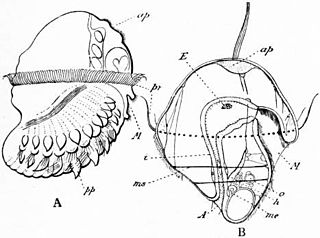
The Serpulidae are a family of sessile, tube-building annelid worms in the class Polychaeta. The members of this family differ from other sabellid tube worms in that they have a specialized operculum that blocks the entrance of their tubes when they withdraw into the tubes. In addition, serpulids secrete tubes of calcium carbonate. Serpulids are the most important biomineralizers among annelids. About 300 species in the family Serpulidae are known, all but one of which live in saline waters. The earliest serpulids are known from the Permian.
Amphidinium is a genus of dinoflagellates. The type for the genus is Amphidinium operculatum Claparède & Lachmann. The genus includes the species Amphidinium carterae which is used as a model organism.

Gonyaulax is a genus of dinoflagellates with the type species Gonyaulax spinifera Diesing. Gonyaulax belongs to red dinoflagellates and commonly causes red tides.

Sycon is a genus of calcareous sponges belonging to the family Sycettidae. These sponges are small, growing up to 7.5 cm and having length from 2.5 to7.5, and are tube-shaped and often white to cream in colour. It is a genus of sponges. They are known to aquarium hobbyists as "Pineapple" or "Q-Tip" sponges, and are frequent "hitchhikers" accidentally brought in.

Astreopora is a genus of stony corals in the Acroporidae family. Members of the genus are commonly known as star corals and there are seventeen species currently recognized.
Myxillidae is a family of marine demosponges.

Myxilla incrustans is a species of demosponge. It is an encrusting species and is usually yellow.
Defretinella is a genus of parasitic alveolates of the phylum Apicomplexa.

Glomerula is a genus of polychaete worm in the family Sabellidae. It differs from all other Sabellidae in having a calcareous tube and spinose setae. Only one living species, G. piloseta, is known from Lizard Island, Great Barrier Reef, Australia. The oldest fossils of Glomerula are known from the Early Jurassic and their tube microstructure has remained unchanged since then.

Polydora is a genus of annelid worms. It contains marine polychaete species that live in mud, holes bored in rocks, and holes bored in the shells of shellfish.
Erinaceusyllis, previously known as Sphaerosyllis, is a genus belonging to the phylum Annelida, a group known as the segmented worms. This genus consists of several species that were previously described as Sphaerosyllis and as Sphaerosyllis erinaceus sub-species, differing by the compound chaetae.
Sphaerosyllis georgeharrisoni is a species belonging to the phylum Annelida, a group known as the segmented worms. Sphaerosyllis georgeharrisoni is distinct by its large parapodial glands with hyaline material; by its small size; short proventricle; a median antenna that is inserted posteriorly to the lateral antennae; as well as long pygidial papillae. Juveniles of S. hirsuta are very similar to this species. Sphaerosyllis pygipapillata has all of its antennae aligned, a smooth dorsum, while its pygidial papillae are longer and slender. The species' name honours George Harrison, musician who died prior to the species' describing article's publication.
Alloeocarpa is a genus of ascidian tunicates in the family Styelidae.

Phyllodocidae is a family of polychaete worms. Worms in this family live on the seabed and may burrow under the sediment.

Ophryotrocha is a genus of marine polychaete worms in the family Dorvilleidae.

Ophryotrocha puerilis is a species of marine polychaete worms in the order Eunicida. It is native to the northern Atlantic Ocean and the Mediterranean Sea and is the type species of the genus Ophryotrocha.
Phyllochaetopterus is a genus of marine polychaete worms that live in tubes that they construct.

Licnophora is a genus of ciliates in the family Licnophoridae. They typically have an hourglass-like shape and live as ectocommensals on marine animals.

Metopus is a genus of anaerobic organisms from the family of Metopidae.

Lopadorrhynchidae is a family of polychaete worms.












